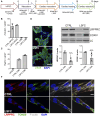Human induced pluripotent stem cells (hiPSCs) derived cells reflect tissue specificity found in patients with Leigh syndrome French Canadian variant (LSFC)
- PMID: 38706791
- PMCID: PMC11066297
- DOI: 10.3389/fgene.2024.1375467
Human induced pluripotent stem cells (hiPSCs) derived cells reflect tissue specificity found in patients with Leigh syndrome French Canadian variant (LSFC)
Abstract
Leigh syndrome French Canadian type (LSFC) is a recessive neurodegenerative disease characterized by tissue-specific deficiency in cytochrome c oxidase (COX), the fourth complex in the oxidative phosphorylation system. LSFC is caused by mutations in the leucine rich pentatricopeptide repeat containing gene (LRPPRC). Most LSFC patients in Quebec are homozygous for an A354V substitution that causes a decrease in the expression of the LRPPRC protein. While LRPPRC is ubiquitously expressed and is involved in multiple cellular functions, tissue-specific expression of LRPPRC and COX activity is correlated with clinical features. In this proof-of-principle study, we developed human induced pluripotent stem cell (hiPSC)-based models from fibroblasts taken from a patient with LSFC, homozygous for the LRPPRC*354V allele, and from a control, homozygous for the LRPPRC*A354 allele. Specifically, for both of these fibroblast lines we generated hiPSC, hiPSC-derived cardiomyocytes (hiPSC-CMs) and hepatocyte-like cell (hiPSC-HLCs) lines, as well as the three germ layers. We observed that LRPPRC protein expression is reduced in all cell lines/layers derived from LSFC patient compared to control cells, with a reduction ranging from ∼70% in hiPSC-CMs to undetectable levels in hiPSC-HLC, reflecting tissue heterogeneity observed in patient tissues. We next performed exploratory analyses of these cell lines and observed that COX protein expression was reduced in all cell lines derived from LSFC patient compared to control cells. We also observed that mutant LRPPRC was associated with altered expression of key markers of endoplasmic reticulum stress response in hiPSC-HLCs but not in other cell types that were tested. While this demonstrates feasibility of the approach to experimentally study genotype-based differences that have tissue-specific impacts, this study will need to be extended to a larger number of patients and controls to not only validate the current observations but also to delve more deeply in the pathogenic mechanisms of LSFC.
Keywords: Leigh syndrome French Canadian type; cardiomyocyte cells; disease modeling; hepatocyte-like cells; induced pluripotent stem cells; three germ layers.
Copyright © 2024 Gélinas, Lévesque, Thompson Legault, Rivard, Villeneuve, Laprise and Rioux.
Conflict of interest statement
The authors declare that the research was conducted in the absence of any commercial or financial relationships that could be construed as a potential conflict of interest.
Figures




References
-
- Burelle Y., Bemeur C., Rivard M. E., Thompson Legault J., Boucher G., Consortium L., et al. (2015). Mitochondrial vulnerability and increased susceptibility to nutrient-induced cytotoxicity in fibroblasts from leigh syndrome French canadian patients. PLoS One 10, e0120767. 10.1371/journal.pone.0120767 - DOI - PMC - PubMed
LinkOut - more resources
Full Text Sources
Research Materials

